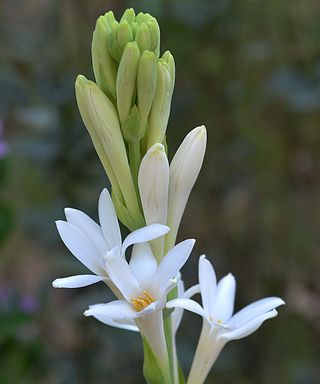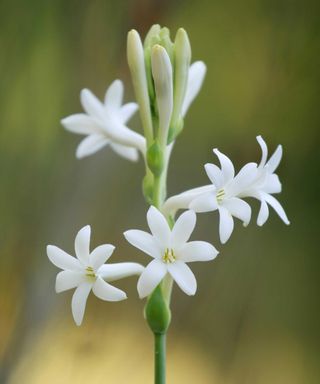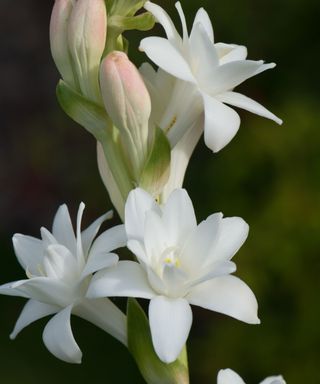Everything you need to know to ensure one of the most fragrant flowers you can grow thrives in your garden
Tuberose is one of the most deliciously fragranced flowers you can add to your planting design. The clusters of waxy white blooms have a strong spicy scent that’s often used in perfumes and candles. This means they’re a great cut flower for the house too, as well as star performers in the summer garden.
This semi-succulent plant is part of the agave family, so despite the name it’s not a true rose. The roots are tuberous bulbs that multiply quickly if conditions are right. The clusters of trumpet-shaped flowers in white, cream and soft pink colors are held on tall slender spikes that add a vertical accent to planting.
This makes tuberose one of the best perennials if you’re looking for a combination of summer scent and luxe blooms. Now find out how to grow tuberose to enjoy this intoxicating beauty in your garden.

How to grow tuberose
If you’re looking for an easy-care scented option for the summer garden make tuberose your go-to.
‘Tuberose are best known for their incredible fragrance and stunning flowers and are used in the cut flower industry because of it,’ says horticulturist Peggy Anne Montgomery. ‘Some say they are the most fragrant flower in the world. Their waxy white flowers remind me of stephanotis.’
Tuberose look great planted en masse in flower beds and borders, edging the walkway to your front door, or filling pots as part of your summer container planting ideas on a sun-filled patio or porch where you can best enjoy the scent up close.
Growing habits of tuberose

‘Polianthes tuberosa, commonly known as tuberose, is a bulb (actually a tuberous rooted rhizome) that is hardy in zones 7 to 10,’ explains Peggy Anne.’ It has a unique story. While it is likely native to Mexico and has been in cultivation since pre-Columbian times, it is not known to exist naturally in the wild today.’
There are many varieties to choose from. Although most commonly white you can also get pink varieties of tuberose. ‘Besides the pearly white flowers, they are now available in shades of cherry, pink, and even yellow,’ says Peggy Anne, ‘They also come in single and double varieties. The flower stems have an impressive show of flowers and buds rising above grass-like foliage.’
Most types grow between 2-3 feet high and spread about 1 foot wide, making them ideal for a display in large pots too. ‘They work wonderfully well in containers with regular water and organic bulb fertilizer.’
Tuberose plants are easy to grow and low-maintenance. The good news is that although they multiply quickly they’re not invasive. Their semi-succulent nature means that as long as you plant them in the right spot they don’t need much looking after.
What’s more, tuberose is relatively pest-free. ‘They don’t have serious pest or disease problems, but keep an eye
Growing advice for tuberose

Soil: ‘Grow tuberose in rich, fertile, well-drained soil with consistent moisture in summer,’ says horticulturalist Jenny Rose Carey. Their tuberous roots will rot if they sit in wet soil. Sandy soil is good for these plants but will need amending, while loose, loamy soil is ideal. A slightly acidic pH is best, in the range of 6.0-6.5.
Light: These plants need full sun to produce the best flowers, around six to eight hours per day for optimal flowering. Plant yours in a spot that receives plenty of sunlight for most of the day. If you live in a hot climate give your plants some shade in the afternoon for protection. A layer of mulch around the base of the plant will also help to retain some moisture in the soil.
Watering: If you experience very dry weather during the growing season, you’ll need to water your plant regularly to prevent it wilting. At the same time it’s important not to over-water tuberose, which will expose the roots to the risk of fungal rot. If you live in a humid climate ensure proper air circulation around your plant too, and only water when the surface of the soil is dry.
Fertilizing: Tuberose are heavy feeders so need plenty of nutrients if you want to get the most flowers. During the growing season, fertilize your tuberose every four to six weeks. If you plant them in poor soil or neglect to fertilize them, they will usually still flower but not as prolifically. It’s a good idea to apply a slow-release, granular fertilizer at the beginning of the season. A fertilizer that is rich in phosphorus will encourage more flowers. Allowing your tuberose plants to spread around without dividing them every couple of years will reduce the amount of flowers you get, so reorganize clumps regularly and be sure to share any overs with neighbors and friends.
Pruning: During the growing season trim off any brown or yellow foliage, as well as deadheading your tuberose regularly to prompt flower production. The more stems you cut from the plant for maintenance or indoor displays, the more it will produce. In fall wait until the first frost before pruning dead foliage. In warm climates cut the foliage down to about six inches tall at the end of the growing season. ‘When the foliage wilts and begins to turn yellow in fall, taper off watering too,’ says Peggy Anne Montgomery. ‘When dry, the bulbs can be lifted and stored indoors.’
By Sarah Wilson – homesandgardens

